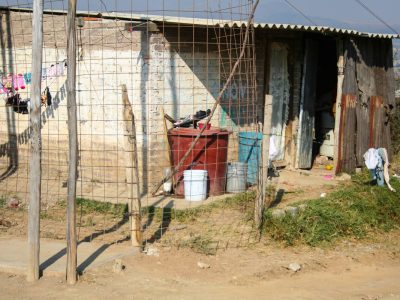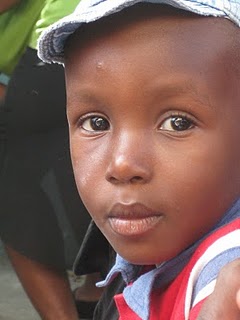As Buildings Shook and Crumbled
Compassion Canada CEO Barry Slauenwhite and a group of fellow Canadians were met at the Port-au-Prince airport on Jan. 12 with an unexpected diplomatic reception. It lasted only 15 or 20 minutes, but it was long enough to possibly save their lives.
Barry was leading a weeklong vision trip for six Canadian pastors and their wives. Their home for the week was to be the Hotel Montana. But less than an hour after landing in Haiti, it became clear that this trip would take a very different turn.
Continue Reading ›Clean Water for Haiti
The critical need the poor always have for water has been heightened in Haiti after the earthquake. We’ve used various ways to distribute water to our church partners, and we’re looking to our strategic partnerships to continue to meet the short- and long-term needs.
We have a long-standing relationship with Healing Waters International, providing water systems to church partners in Guatemala and the Dominican Republic.
 In response to the immense need in Haiti, Healing Waters International has provided 2,500 one-gallon jugs of water at no cost to Compassion Haiti. The water was bottled at the Healing Waters projects at our Dominican Republic church partner sites. If there is continued need, they are equipped to begin bottling on a daily basis.
In response to the immense need in Haiti, Healing Waters International has provided 2,500 one-gallon jugs of water at no cost to Compassion Haiti. The water was bottled at the Healing Waters projects at our Dominican Republic church partner sites. If there is continued need, they are equipped to begin bottling on a daily basis.
The water will be trucked to Haiti along with the family food kits being assembled at our warehouse on the Dominican Republic/Haiti border.
We will also investigate several long-term solutions, such as building water systems at church partner sites in Haiti.
According to Gregg Keen, our Complementary Interventions Director,
“Healing Waters International and Compassion have been good partners for several years. When the disaster hit Haiti, Healing Waters was among the first organizations we called to ask what their response would be. They went to heroic efforts to find available water bottles in the DR when none could be found there. Bottled water will help people to avoid drinking and using contaminated water and the related diseases they can cause, especially in a disaster situation like this one. The impact of this can’t even be measured.”
Healing Waters’ mission is to empower local ministry partners to bring physical, social and spiritual transformation to poor communities, a mission that makes them an excellent partner for us.
Read more about our partnership with Healing Waters International.
Continue Reading ›Serving the Garo Tribe in Bangladesh
The Garo community is one of the major tribes in Bangladesh. According to the history books, the Garo tribe entered Bangladesh in the first century. They were refugees from Mongolia and came to this region through Tibet.
The Garo have stayed in Bangladesh for thousands of years. Initially, they followed a religion called Sonatoni. Today, nearly 100 percent of the Garo tribe practices Christianity, though a few still believe in Sonatoni.
Garos have their own language, Achick, which is completely different from the local language, Bengali. Achik has several accents/branches such as Habeng, Attong, etc.
The Garo tribe also has its own culture. Their dress, food habits and celebration styles can be easily distinguished from the Bengalis and other tribes.
The people from the Garo tribe have different features than the original inhabitants of Bangladesh (Bengali people). They are a little shorter and have fair skin. Their eyes and nose are similar to their ancestors from Mongolia.
Compared to the other tribal groups, the Garo tribe is little advanced in education and social activities. The first Garo church (Garo Baptist Convention) was established in 1910. Many missionaries and evangelists from Europe and North America worked among the Garo people over the decades.

What Is Life Like for Mexico’s Suburban Poor?
Our child development centers are distributed in different types of settings in Mexico; the biggest difference is between urban and suburban areas. In the context of this blog post, the term “suburban” is defined a bit differently than in the developed world: Suburban areas are smaller cities or towns, normally located on the outskirts of main cities, with at least 5,000 inhabitants, but with few services.
Help Haiti
We’ve been helping Haiti for more than 40 years — teaching, feeding, educating, loving, mentoring, caring and most importantly, sharing the Good News of Jesus Christ.
Will you join us in helping Haiti rebuild?
Thoughts on Haiti From Haiti: 21 Days Later
This was written yesterday by Bob Thorp, a member of our Complementary Interventions team, who has been in Haiti working with our staff since shortly after the earthquake.
“I’ve witnessed a metamorphosis here since arriving here 21 days ago. Then, the words I could use to describe what I saw was a whole city in shock, walking around like zombies, walking wounded. Blank stares. Hollow eyes, caked with mud, now dry from an inability to produce more tears. A survival mentality had set in – each one for themselves. Walk right past someone trapped, because they needed to get home to find their own loved ones.
“Today, car horns blare from 4:00am on late into the night. The continual roar of traffic, occasional squealing of tires, movement everywhere. Life is returning to Port-au-Prince. It started like a drip – in dire need of food and water, street vendors started setting up shop – hawking anything and everything. Fruits and vegetables started appearing. Clothes, used and new – recovered from the rubble of someone else’s house – who knows – now hand on clothes hangers covering a filthy crumbling wall like royal curtains. Mountains of shoes have also made it to the street vendors. Even seen a place where you could buy just one shoe! Not sure why, either they had a niche for those that could only find one of their shoes. Or more morbid, selling shoes to all those who lost limbs because of this tragedy.”
Read the entire blog post.

What Is Life Like for the Urban Poor in Mexico’s Cities?
Our child development centers are distributed in different types of settings in Mexico; the biggest difference is between urban and suburban areas.
In the context of this blog post, the terms “urban” is defined a bit differently than in the big cities of the developed world: An urban area corresponds to small communities concentrated in cities with more than 10,000 inhabitants, with the majority of public services at hand.
Roberto Medrano: My Best Day in Ministry
Roberto Medrano has worked for Compassion for seven years and now serves as a Learning and Support Specialist for communication and tours in the Central America and Caribbean region.
Child Sponsorship: How Do We Choose Which Children to Register?
No more than three children from the same family can be registered in our Child Sponsorship Program, though each country may choose to limit this to fewer children so they can help a larger number of families.
Life in Haiti After the Earthquake: It Just Hurts
Received from Scott Todd, our Senior Ministry Advisor, who is leading our medical team in Port-au-Prince.
Saturday, Jan. 30 – We had the chance to meet eight leadership students today. We sat in a circle in the parking lot listening to their stories as ashes drifted like snow upon us and the smell of burning plastics scorched the air.
They spoke of how important Compassion’s work has been in their lives. Some shared with tears about being selected for the Leadership Development Program. I don’t know whether the tears flowed from joy, gratitude or something sad.
Like the dream that almost came true. They had climbed so high. From the slums to the universities. But when we asked how many went to schools which had been damaged in the earthquake all of them raised their hands.
We asked how many had lost friends or loved ones and all raised their hands again.
At one school 90 percent (180 out of 200) of the students were killed. With buildings collapsed, professors and administrators dead, its hard to imagine how those dreams can come true now.
May God have mercy on us if we fail to find a way forward for them. They are Haiti’s future.

 “I’ve witnessed a metamorphosis here since arriving here 21 days ago. Then, the words I could use to describe what I saw was a whole city in shock, walking around like zombies, walking wounded. Blank stares. Hollow eyes, caked with mud, now dry from an inability to produce more tears. A survival mentality had set in – each one for themselves. Walk right past someone trapped, because they needed to get home to find their own loved ones.
“I’ve witnessed a metamorphosis here since arriving here 21 days ago. Then, the words I could use to describe what I saw was a whole city in shock, walking around like zombies, walking wounded. Blank stares. Hollow eyes, caked with mud, now dry from an inability to produce more tears. A survival mentality had set in – each one for themselves. Walk right past someone trapped, because they needed to get home to find their own loved ones.
